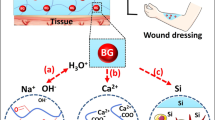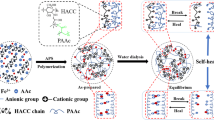Abstract
Sodium alginate and carboxymethyl chitosan have been extensively applied in tissue engineering and other relative fields due to their low price and excellent biocompatibility. In this paper, we oxidized sodium alginate with sodium periodate to convert 1,2-hydroxyl groups into aldehyde groups to get aldehyde-sodium alginate (ASA). Carboxymethyl chitosan was modified with ethylenediamine (ED) in the presence of water-soluble N-(3-Dimethylaminopropyl)-N′-ethylcarbodiimide hydrochloride (EDC) to introduce additional amino groups to get amino-carboxymethyl chitosan (A-CS). Upon mixing the A-SA and A-CS aqueous solutions together, a gel rapidly formed based on the Schiff’s base reaction between aldehyde groups in A-SA and amino groups in A-CS. FTIR analysis confirmed the characteristic peak of Schiff’s base group in the hydrogel. It was confirmed that the gelation time be dependent on the aldehyde group content in A-SA and amino group content in A-CS. The fasted hydrogel formation takes place within 10 min. The data of bonding strength and cytotoxicity measurement also showed that the hydrogel had good adhesion and biocompatibility. All these results support that this gel has the potential as soft tissue adhesive.
Similar content being viewed by others
References
Lloyd J D, Marque M J 3rd, Kacprowicz R F. Closure techniques. Emergency Medicine Clinics of North America, 2007, 25(1): 73–81
Yang T L. Chitin-based materials in tissue engineering: applications in soft tissue and epithelial organ. International Journal of Molecular Sciences, 2011, 12(3): 1936–1963
Ladewig K. Drug delivery in soft tissue engineering. Expert Opinion on Drug Delivery, 2011, 8(9): 1175–1188
Tay C Y, Irvine S A, Boey F Y, et al. Micro-/nano-engineered cellular responses for soft tissue engineering and biomedical applications. Small, 2011, 7(10): 1361–1378
Zhang F, He C, Cao L, et al. Fabrication of gelatin-hyaluronic acid hybrid scaffolds with tunable porous structures for soft tissue engineering. International Journal of Biological Macromolecules, 2011, 48(3): 474–481
Ryu J H, Lee Y, Kong W H, et al. Catechol-functionalized chitosan/pluronic hydrogels for tissue adhesives and hemostatic materials. Biomacromolecules, 2011, 12(7): 2653–2659
Lee Y, Chung H J, Yeo S, et al. Thermo-sensitive, injectable, and tissue adhesive sol–gel transition hyaluronic acid/pluronic composite hydrogels prepared from bio-inspired catechol-thiol reaction. Soft Matter, 2010, 6(5): 977–983
Quinn J, Wells G, Sutcliffe T, et al. Tissue adhesive versus suture wound repair at 1 year: randomized clinical trial correlating early, 3-month, and 1-year cosmetic outcome. Annals of Emergency Medicine, 1998, 32(6): 645–649
Chung H, Grubbs R H. Rapidly cross-linkable DOPA containing terpolymer adhesives and PEG-based cross-linkers for biomedical applications. Macromolecules, 2012, 45(24): 9666–9673
Balakrishnan B, Banerjee R. Biopolymer-based hydrogels for cartilage tissue engineering. Chemical Reviews, 2011, 111(8): 4453–4474
Smith T J, Kennedy J E, Higginbotham C L. Rheological and thermal characteristics of a two phase hydrogel system for potential wound healing applications. Journal of Materials Science, 2010, 45(11): 2884–2891
Balakrishnan B, Jayakrishnan A. Self-cross-linking biopolymers as injectable in situ forming biodegradable scaffolds. Biomaterials, 2005, 26(18): 3941–3951
Mo X, Iwata H, Matsuda S, et al. Soft tissue adhesive composed of modified gelatin and polysaccharides. Journal of Biomaterials Science Polymer Edition, 2000, 11(4): 341–351
Yuan L, Wu Y, Fang J, et al. Modified alginate and gelatin crosslinked hydrogels for soft tissue adhesive. Artificial Cells, Nanomedicine, and Biotechnology, 2017, 45(1): 76–83
Gomez C, Rinaudo M, Villar M. Oxidation of sodium alginate and characterization of the oxidized derivatives. Carbohydrate Polymers, 2007, 67(3): 296–304
Balakrishnan B, Mohanty M, Umashankar P R, et al. Evaluation of an in situ forming hydrogel wound dressing based on oxidized alginate and gelatin. Biomaterials, 2005, 26(32): 6335–6342
Geng X, Mo X, Fan L, et al. Hierarchically designed injectable hydrogel from oxidized dextran, amino gelatin and 4-arm poly (ethylene glycol)-acrylate for tissue engineering application. Journal of Materials Chemistry, 2012, 22(48): 25130–25139
Mo X, Iwata H, Ikada Y. A tissue adhesives evaluated in vitro and in vivo analysis. Journal of Biomedical Materials Research Part A, 2010, 94(1): 326–332
Hoare D G, Olson A, Koshland D E Jr. The reaction of hydroxamic acids with water-soluble carbodiimides. A Lossen rearrangement. Journal of the American Chemical Society, 1968, 90(6): 1638–1643
Geng X H, Yuan L, Mo X M. Oxidized dextran/amino gelatin/ hyaluronic acid semi-interpenetrating network hydrogels for tissue engineering application. Advanced Materials Research, 2013, 627: 745–750
Acknowledgements
The authors sincerely appreciate the supports of the National Major Research Program of China (2016YFC1100202), the National Natural Science Foundation of China (Grant No. 31470941), the Yantai Double Hundred Talent Plan, and the “111 Project” Biomedical Textile Materials Science and Technology, China (Grant No. B07024).
Author information
Authors and Affiliations
Corresponding author
Rights and permissions
About this article
Cite this article
Wu, Y., Yuan, L., Sheng, Na. et al. A soft tissue adhesive based on aldehyde-sodium alginate and amino-carboxymethyl chitosan preparation through the Schiff reaction. Front. Mater. Sci. 11, 215–222 (2017). https://doi.org/10.1007/s11706-017-0392-x
Received:
Accepted:
Published:
Issue Date:
DOI: https://doi.org/10.1007/s11706-017-0392-x




